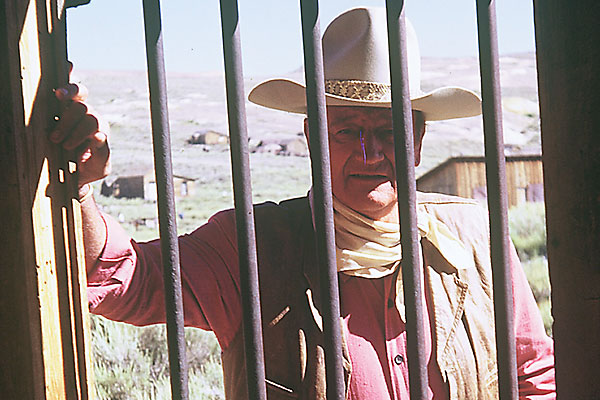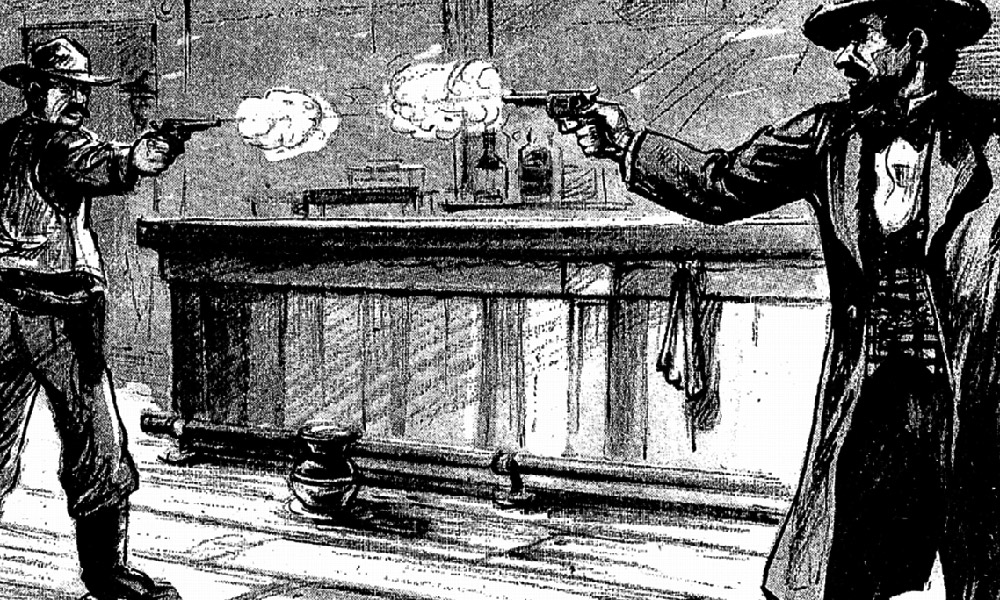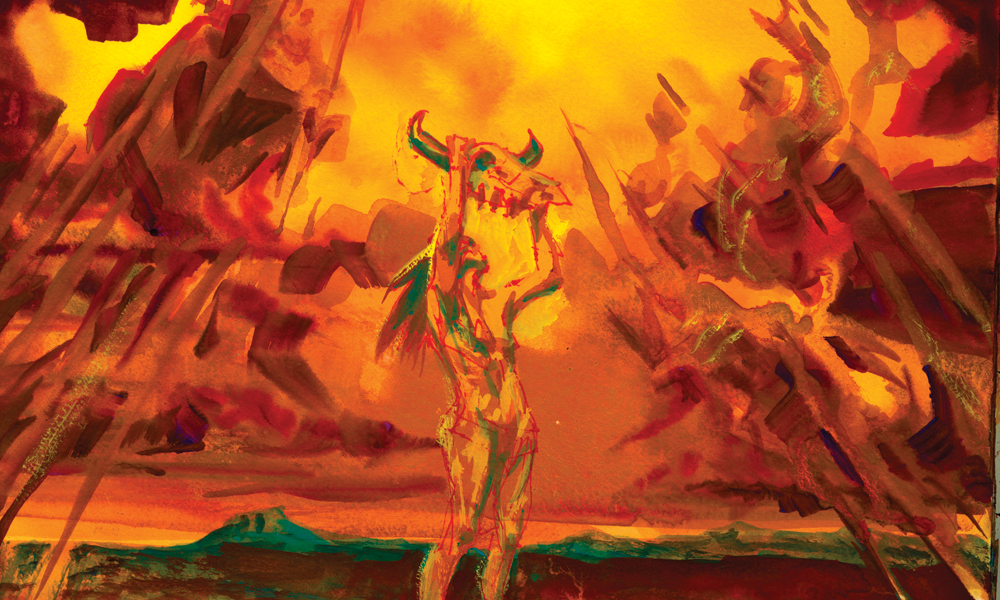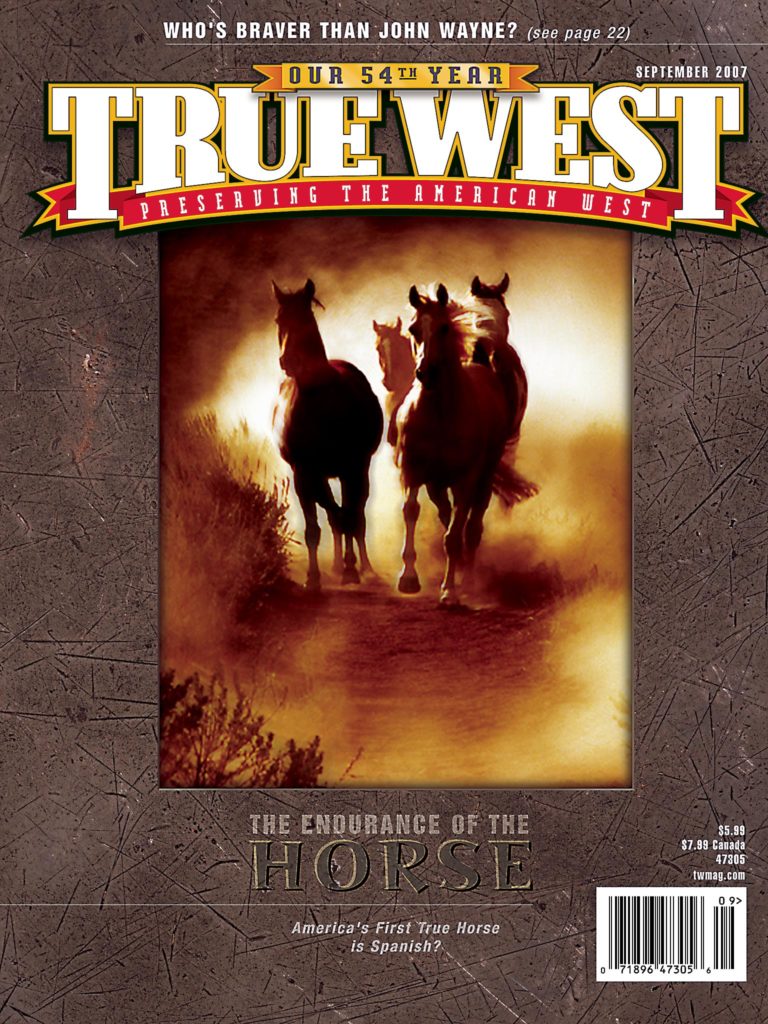
Bodie is a ghost town—perhaps the West’s best preserved ghost town, where abandoned weather-beaten buildings stand stoically against encroaching sagebrush.
But years ago, the remote mining camp east of the Sierra Nevada Mountains in California became the object of a gold rush that gave rise to one of the West’s wildest boomtowns. Saloon brawls, stagecoach robberies, vigilante justice and gunfights earned Bodie a reputation for violence that rivaled Tombstone, Deadwood and Dodge City. Those boomtowns are famous today, recognized largely for celebrated gunmen who stalked their streets, such as Wyatt Earp, Doc Holliday and Wild Bill Hickok. Yet Bodie’s killers, depraved or otherwise, were soon forgotten.
Still, Bodie’s penchant for trouble gave rise to one legendary figure. Though his fame was short-lived, the “Bad Man From Bodie” was a name recognized across the country. Evoking peril, “bad man” was a popular 19th-century expression that meant “ruffian,” “tough guy” or “cold-blooded murderer.”
Did the “Bad Man From Bodie” really exist? Or does he just stand exemplar for the shady characters who drifted through the dangerous boomtown?
Gambling on Bodie
After prospector W.S. Bodey and his companions discovered gold in 1859, Bodie remained nearly unpopulated until a cave-in exposed an ore body that inspired San Francisco speculators to set up industrial-scale mining. Their gamble paid off in late 1877, when the mine produced $784,523 in gold and silver bullion, and investors received four consecutive monthly dividends. The company’s good luck infected the nation’s investing community with gold fever and aroused fortune hunters who headed for Bodie. As the population swelled past 1,000 restless souls, the mining outpost’s startup newspaper summarized the situation.
Gold—But a few short months ago Bodie was an insignificant little place, now she is rapidly growing in size and importance and people are crowding in upon her from far and near, and why? Because of the rich discoveries of gold—yellow, glittering, precious gold.
Except for a few minor altercations, Bodie remained peaceful during the early months of the excitement. But on January 15, 1878, gunfire pierced the wintry air. In the initial moments of the exchange, James Blair, age 28, received a bullet in the left arm near the shoulder, but he continued firing until John Bresnan, age 30, lay dead. A week later, doctors administered chloroform and operated on Blair’s arm. They removed the shattered upper portion of his humerus bone, but the patient died 26 days after the street fight. Some 20 miles away, at the county courthouse in Bridgeport, the recorder wrote the names Bresnan and Blair on a clean page in the spanking new Mono County Register of Deaths, an impressive leather-bound volume adorned with gold lettering. The official record of violence at Bodie had begun.
Bluffer Washoe Pete
Boomtown Bodie churned with activity in spring 1878, when newly unearthed bonanza veins attracted even more gold seekers, multiplying the camp’s population five times over before year’s end. Just days before the discoveries, San Francisco’s Argonaut published a tall tale by journalist and humorist E.H. Clough that spoofed the distant mining town’s rough-and-tumble inhabitants. Titled “The Bad Man of Bodie,” the story told of Washoe Pete, a “bluffer” whose wild exaggerations were sources of amusement. “He swaggered and boasted to his heart’s content,” the yarn began. Whenever Pete drew his revolver and shot out the lights, he only evoked onlooker smiles and remarks of “purty fair shootin’.”
One day, Pete entered a saloon where he encountered a meek, peaceful mining expert. “You are an expert, eh?” shouted Bodie’s baddest bad man, eyeing the newcomer menacingly. “You’re one o’ them fellers as allows he knows payin’ mines, are ye? Well, ye’re the wust I ever saw.”
“I don’t want to quarrel with you, sir,” responded the expert.
“Ye’d better not, young feller, ye’d better not. I’m a whirlwind in a fight, and don’t ye forget it.”
“I’m a man of peace,” the cowering visitor pleaded. “I carry no weapons, and of course I could not hope to stand before an untamed whirlwind.”
Pete leaned over the stranger and shook his fist in the man’s face as if preparing to annihilate him. “I’m bad; I’m chief in this yer camp, an’ I ken lick the man who says I ain’t. I’m a ragin’ lion o’ the plains, an’ every time I hit I kill. I’ve got an arm like a quartz stamp, an’ I crush bones when I strike.”
“Please don’t joke so roughly,” pleaded the helpless expert. “Let’s take a drink and call it square. I’m very sorry that I have offended you.”
“Ye think I’m jokin’, do ye?” hollered the bad man. “Ye take me for a josh, eh? I’ll show ye what I am afore I git through with ye. Ye don’t play me fur no tenderfoot.”
By this time a crowd had filled the room; all smiling and enjoying the drama.
“This has gone on ’bout long ’nough,” yelled Bodie’s bad man. “Square yerself—I’m goin’ ter kick, an’ a Comstock mule ain’t no match for Washoe Pete—d’ye hear me?”
The bully raised his ponderous boot. But just then the little man straightened up and his left fist struck Pete between the eyes like a locomotive piston. The blow sent the surprised bully sprawling onto the sawdust-covered floor. The expert pounced on his victim, drew back, and struck again. Then blows fell like thunderbolts. Pete reached for his knife and six-shooter, but the little man flanked his moves and planted more punches on the braggart’s prostrate form.
“Let up!” the tyrant howled. “I was only foolin’—can’t yer take a joke, dern ye? I give in, dern ye, I give in!”
The sight was too much for the onlookers, and their laughter echoed through the hills beyond Bodie Bluff.
Rising from his victim, the victorious expert called out “all hands to the bar for drinks.”
Meanwhile, the “Bad Man of Bodie” crawled away muttering to himself, “I didn’t lay out to fall up against batterin’ rams.”
The yarn played upon Bodie’s growing reputation for violence. After the Reno Record reported that in December 1878 a man was cut to pieces in Bodie, the Gold Hill News queried, “Why can’t a man get along in Bodie without fighting?” Bodie’s press answered whimsically, blaming the district’s 8,500-foot elevation.
Really, we can’t say. It must be the altitude. There is some irresistible power in Bodie which impels us to cut and shoot each other. . . . The clashing of revolvers up and down Main street can be constantly heard, and . . . a man cannot go to his dinner without getting a bullet hole in his hat, or the seat of his unmentionables cut away by the deadly knife of the desperado. Yes, it is sad, but only too true, that everybody must fight that comes to Bodie.
Tall tales of the West that portrayed its inhabitants as unsophisticated, ornery and dangerous were popular across America. Even the Boston Daily Globe amused East Coast readers in July 1879 by describing a stranger who “staggered” into a tony drinking establishment.
“Everybody come up and have something to drink,” demanded the newcomer as he lurched up to the bar. He gave a furious whoop and smashed a bottle over his head. Then the brute performed a war dance and declared, “I’m a bad man and always make it a practice to strew upon the floor the bowels of any person who declines to drink upon my invitation.”
Affirming his remarks, he drew an 18-inch “Arkansas toothpick” from the back of his collar, sending patrons stampeding for the exits.
“Who is he?” muttered a terrified spectator as he took cover behind the bar, “From Bodie, I suppose.”
“Bodie, hell no!” thundered the bartender. “He’s from Boston. He belongs to that Sunday-school excursion.”
Stories of Deviltry
Americans had long enjoyed mixing fantasy with reality so that by 1830, their storytelling knack had elevated leg pulling to a national art form. The frontier and its heroes were popular subjects, but gold and silver discoveries in the West provided fertile ground for even more incredible tales. Some mining fables were not always in good fun, beginning with gold rush stories of fist-size nuggets and other humbugs. At Bodie, as with most mining camps of its day, fraudulent reports of rich mineral strikes manipulated stock prices to swindle investors for the benefit of well-connected insiders.
Blurring the line between fact and fiction, “Bad Man From Bodie” stories followed a rich tradition of playful exaggeration for entertainment’s sake. Fanciful characters, such as Paul Bunyan and Pecos Bill, remain popular today, but when the West was wild, tales of Bodie’s bad man drew upon exaggerated stories about the community’s utter disregard for law and order and almost surpassed over-inflated reports of wealth in its mines. Even New York’s prestigious Engineering and Mining Journal departed from printing mining news and reported with a touch of hyperbole that “Bodie contains about 6,000 inhabitants, who support 156 drinking places, several newspapers, and many attorneys-at-law, without a single church.”
Newspaper editors far and wide, it seemed, took pleasure in embellishing stories of deviltry and attributing them to any passing stranger who could be conveniently labeled a “Bad Man From Bodie.” In a San Francisco courtroom, a defendant charged with “vulgar language” argued that the city’s press had unfairly dubbed him the Bad Man From Bodie.
“I have been mortified by glaring headlines,” complained W.H. Branch.
“I am suspected of carrying nitroglycerine in each pocket, of having a large and ugly-shaped knife in each boot and a brace of pistols in my belt.” The defendant begged for leniency, arguing that the reports were overstated. “Yes, your honor,” he implored. “Despite the implication, I have never been in Bodie in my life!”
Clough’s Bad Man
The expression “Bad Man From Bodie” had become well known by 1880, when the writer who coined the term two years earlier published a second tale that appeared in Sacramento’s Daily Bee.
“Having made a close study of the peculiar class of ‘bad men’ generally known as Bad Men from Bodie,” E.H. Clough proclaimed, “I am prepared to add my plethora of wisdom in this respect to that already extant in the world at the present time.” Dropping Washoe Pete from the story line, Clough spun a yarn about another equally improbable character.
One of the peculiarities of a Bad Man From Bodie is his profanity. A Bad Man From Bodie who never used an oath is as impossible as perpetual motion or an honest election in Nevada. This trait is especially noticeable whenever he kills a man or endeavors to kill one. . . . Meeting an eligible candidate for a place in the graveyard, he emits his stereotyped oath and blazes away.
The columnist claimed to have actually witnessed a Bodie bad man enter a saloon and leap upon a billiard table.
“Here I am again,” the make-believe thug shouted, “a mile wide and all wool. I weigh a ton and when I walk the earth shakes. Give me room and I’ll whip an army. . . . I was born in a powder house and raised in a gun factory. I’m bad from the bottom up and clear grit plumb through.”
From atop the pool table, the bad man roared, “I’m chief of Murdertown, and I’m dry! Whose treat is it? Don’t all speak at once for I’ll turn loose and scatter death and destruction Hell bent for election. Your treat, is it? Well, come up everybody. Pass the old
rat poison.”
Whenever a Bodie bad man entered a mining camp, Clough added, the locals would wring their hands and say, “Reckon it’s goin’ to liven up around here; I see the bonebreaker’s in town.” Then the undertaker would dust off his hearse and groom its black plumes; the coroner would convene a jury to hold inquests and make arrangements with the physician for autopsies; the gravedigger would buy a new spade; and the stonecutter, who “epitaphs the dead” on marble, would put in a stock of new chisels.
Clough’s wild stories inspired other writers, who drew inspiration from Bodie’s lawless inclination. Another tale described an inebriated loudmouth who entered the Fern Leaf concert hall in San Francisco.
“I’m a chip from the side of Bodie Bluff,” the stranger yelled as he upset a table and jumped onto the stage, driving a terrified soloist into a corner. “I’m an old stager myself, and capture whole camps with my actin’.”
The intruder pulled his gun and fired a shot, extinguishing the footlights and sending musicians and the audience fleeing toward the door.
“This is what I call fun,” proclaimed the bad man. “This old town needs shaking up a little; the boys seem to be sort o’ low and need a boom.”
A Gross Injustice
Violent stories, both real and fabricated, gave Bodie an air of danger, an aspect of the camp’s far-flung fame that delighted some but troubled others. One Bodie editor challenged the motives and accuracy of distant-city reporting:
When the witty paragrapher of one of our metropolitan contemporaries has touched up all the live topics of the day, and still lacks a little filling of the space in his paper, he dashes off a few lines about the “bad man of Bodie,” and his exploits in the way of “cleaning out” a saloon full of city loafers, blowing out lights with his revolver, or other equally improbable performances. In brief, we do not enjoy having our town pointed out either as a murderer’s paradise or the chosen headquarters of the Angel of Death, because neither proposition is true. The fact is, the “bad man of Bodie” is as much a myth, and is as unreal as “the baseless fabric of a vision.” He does not exist.
The columnist later admitted that killings actually did take place in Bodie, but only among its rowdy citizens.
As to the occasional homicides which occur here, there never has been yet an instance of the intentional killing of a man [that] was not a verification of the proverb that “He that liveth by the sword shall perish by the sword.” As to the health of Bodie, there were about 111 deaths in this place [during 1879], out of a population varying from 5,000 to 8,000 people. A very considerable number of these were killed by accidents in mines.
One Bodie resident who sought to correct his town’s image visited the Bay Area and complained to the San Francisco Daily Report that “people living at a distance from our mining district often do us a gross injustice in commenting on our fighting affairs. . . . [They] assume that Bodie is a terribly wicked place. . . . The ‘Bad Man from Bodie’ has become a popular phrase and every time a fatal shooting scrape occurs in the town some paper heads its account with ‘Another Bodie fighter gets his man for breakfast.’”
Also objecting to unflattering reports, a newsman in Bodie remarked, “But Bodie is much misunderstood by those outside. They have met with an occasional ‘Bad Man from Bodie,’ and have been too ready to judge the entire community from the bad man’s standpoint.”
While law-abiding citizens sought to change outside opinion, their efforts did little good. Bodie’s violent reputation did not subside until years after the boom. The town’s population decreased precipitously beginning in mid-1880, then leveled off at around 800, comprised of mostly wage-earning miners and their families.
Cowboy One-Ups Bad Man
As the camp matured, its once-famous Bad Man faded into the mists of forgotten folklore, overtaken by a more powerful legendary figure—the cowboy. An article in the New York-based National Police Gazette anticipated the popularity of cowboys and compared them to the Bad Man From Bodie.
The untamed cowboy generally sports a large six shooter, a belt, a knife, repeating rifle, and a huge pair of spurs, while the mustang which he rides is supplied with a Spanish saddle, and held in check and guided by a huge Spanish bit. Herding cattle being his vocation, nothing delights him more than a wild chase after an untamed steer, and, being a splendid rider, neither an Apache nor a soldier can get the best of him on the plains. Sometimes he is an American, sometimes a Mexican, a half-breed, or Indian, but no matter what his nationality may be he is as uncivilized as a grizzly bear and reckless as a savage. . . . He it is who does the shooting in most of our frontier towns, and is fast becoming a terror to the citizens of the region where he chooses to visit. Like “the bad man from Bodie,” fear to him is an unknown quantity, and the greater the danger the more desperate he seems to become.
Marking the early stages of America’s fascination with cowboys, the nationally read tabloid portrayed troublesome ranch hands as equals to Bodie’s hard drinking, reckless mining men. Cowboys, however, gained popularity after Wild West shows, then motion pictures and TV cast them as galloping do-gooders who lived by an imaginary Code of the West. Based on the entertainment value of fast-shooting buckaroos on horseback, action-packed adventures followed phony story lines and depicted cattle driving as if it were the West’s highest calling. Ranching now symbolizes America’s frontier past, suggesting no other occupation—including gold mining—ever existed.
As for the fabled “Bad Man From Bodie,” he faded into obscurity, while cowboys came to symbolize the entire nation.
For a comprehensive history of Bodie and its mines, read Michael H. Piatt’s Bodie: The Mines Are Looking Well…., published by North Bay Books. Visit BodieHistory.com to learn more about Bodie and gold mining technology.





